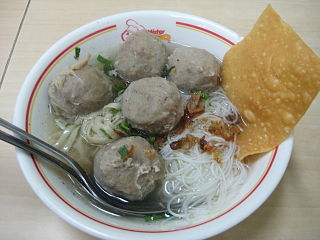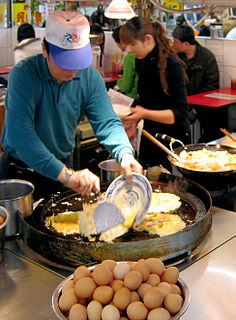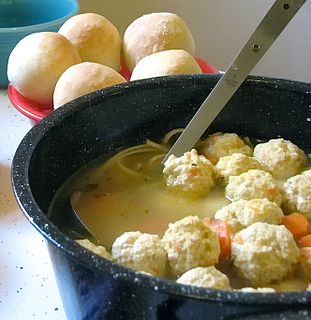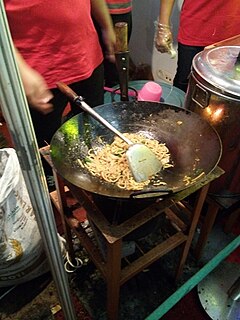
Beef noodle soup is a noodle soup made of stewed or braised beef,beef broth,vegetables and noodles. It exists in various forms throughout East and Southeast Asia.

Singaporean cuisine derived from several ethnic groups which have developed through centuries of political,economic,and social changes of this cosmopolitan city-state.

Fish balls are rounded meat balls made from fish paste which are then boiled or deep fried. Similar in composition to fishcake,fish balls are often made from fish mince or surimi,salt,and a culinary binder such as tapioca flour,corn,or potato starch.

Malaysian Chinese cuisine is derived from the culinary traditions of Chinese Malaysian immigrants and their descendants,who have adapted or modified their culinary traditions under the influence of Malaysian culture as well as immigration patterns of Chinese to Malaysia. Because the vast majority of Chinese Malaysians are descendants of immigrants from southern China,Malaysian Chinese cuisine is predominantly based on an eclectic repertoire of dishes with roots from Fujian,Cantonese,Hakka and Teochew cuisines.
The city of Ipoh is the administrative capital of the Malaysian state of Perak and is famous for its cuisine. Its food culture is driven by its majority Chinese population who are largely of Cantonese and Hakka descent. There is also excellent Malay and Indian food in Ipoh;the nasi kandar served by a prominent local Mamak stall is nicknamed nasi ganja due to its supposed addictive properties. Specialty foods from neighbouring towns are also available in Ipoh.

Noodle soup refers to a variety of soups with noodles and other ingredients served in a light broth. Noodle soup is a common dish across East Asia,Southeast Asia and the Himalayan states of South Asia. Various types of noodles are used,such as rice noodles,wheat noodles and egg noodles.

Chinese Indonesian cuisine is characterized by the mixture of Chinese with local Indonesian style. Chinese Indonesians,mostly descendant of Han ethnic Hokkien speakers,brought their legacy of Chinese cuisine,and modified some of the dishes with the addition of Indonesian ingredients,such as kecap manis,palm sugar,peanut sauce,chili,santan and local spices to form a hybrid Chinese-Indonesian cuisine. Some of the dishes and cakes share the same style as in Malaysia and Singapore which are known as the Nonya cuisine by the Peranakan.

Rice vermicelli is a thin form of a noodle. It is sometimes referred to as 'rice noodles' or 'rice sticks',but should not be confused with cellophane noodles,a different Asian type of vermicelli made from mung bean starch or rice starch rather than rice grains themselves.

Korean–Chinese cuisine or Sino–Korean cuisine is a hybrid cuisine developed by the ethnic Chinese and the ethnic Koreans in both China and South Korea. Despite being derived from Chinese cuisine,Korean Chinese cuisine consists of unique dishes with Korean flavors and ingredients. In South Korea,the food is usually delivered. In the United States and elsewhere,Korean Chinese dishes are typically served in Korean restaurants as well as in Chinese restaurants whose owners are immigrants from Korea.

Soups in East Asian culture are eaten as one of the main dishes in a meal or in some cases served straight with little adornment,particular attention is paid to the soups' stocks. In the case of some soups,the stock ingredients become part of the soup. They are usually based solely on broths and lacking in dairy products such as milk or cream. If thickened,the thickening usually consists of refined starches from corn or sweet potatoes.

Bakso or baso is an Indonesian meatball,or a meat paste made from beef surimi. Its texture is similar to the Chinese beef ball,fish ball,or pork ball. The word bakso may refer to a single meatball or the complete dish of meatball soup. Mie bakso refers to bakso served with yellow noodles and rice vermicelli,while bakso kuah refers to bakso soup served without noodles.

Xiaochi are an important category of Chinese and Taiwanese street food,commonly found in ethnically Han Chinese areas around the world. Xiaochi are substantial snacks,which could be eaten together or with more substantial dishes like the Spanish tapas or Middle Eastern Levantine meze,or alone as a light meal or snack like the French goûter.

A meatball is ground meat rolled into a small ball,sometimes along with other ingredients,such as bread crumbs,minced onion,eggs,butter,and seasoning. Meatballs are cooked by frying,baking,steaming,or braising in sauce. There are many types of meatballs using different types of meats and spices. The term is sometimes extended to meatless versions based on vegetables or fish;the latter are also commonly known as fishballs.

Cart noodle is a noodle dish which became popular in Hong Kong and Macau in the 1950s through independent street vendors operating on roadsides and in public housing estates in low-income districts,using carts. Many street vendors have vanished but the name and style of noodle endures as a cultural icon.

Beef ball is a commonly cooked food in Cantonese and overseas Chinese communities which was originated by Teochew people. As the name suggests,the ball is made of beef that has been finely pulverized,other ground meat such as pork may be the ingredients of the beef balls. They are easily distinguishable from fish balls due to their darker color. Another characteristic is the tiny pieces of tendon in each ball will dissolve with prolonged cooking.
A wonton,also spelled wantan,or wuntun in transliteration from Cantonese;wenden/ɦwəɲd̼əɲ/ in Shanghainese;Mandarin:húntun (馄饨/餛飩) is a type of Chinese dumpling commonly found across regional styles of Chinese cuisine.

Indonesian noodles are a significant aspect of Indonesian cuisine which is itself very diverse. Indonesian cuisine recognizes many types of noodles,with each region of the country often developing its own distinct recipes.

Taiwanese beef noodle soup is a beef noodle soup dish originated in Taiwan. It is sometimes referred to as "Sichuan beef noodle soup" in Taiwan. Although this usage can create confusion as Sichuan has its own versions of beef noodle soups which may be sold at Sichuanese restaurants under the same name. The beef is often stewed with the broth and simmered,sometimes for hours. Chefs also let the stock simmer for long periods with bone marrow;some vendors can cook the beef stock for over 24 hours. In Taiwan,beef noodle vendors may also have optional,often cold side dishes,such as braised dried tofu,seaweed or pork intestine. Beef noodles are often served with suan cai on top,green onion and sometimes other vegetables in the soup as well.

















